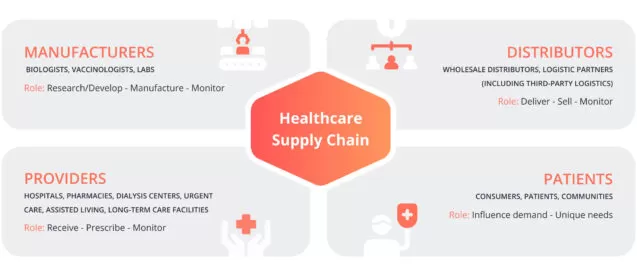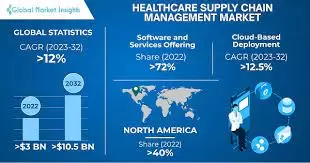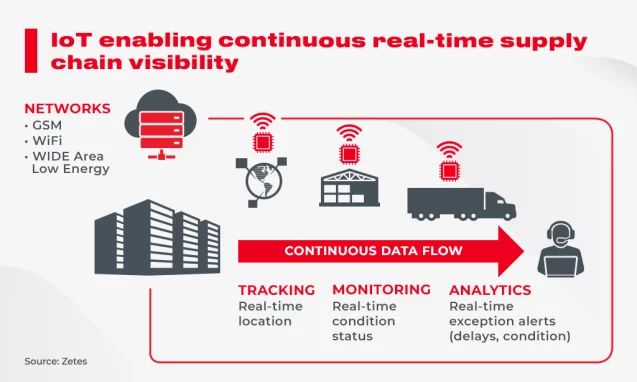In healthcare, optimized supply chain management is more than just logistics — it’s a lifeline. Just imagine a surgeon without a crucial instrument during a procedure or a patient waiting in vain for a vital medication due to a supply chain hiccup. In an industry where seconds can make all the difference between life and death, the efficiency of the supply chain becomes crucial. Accuracy, speed, and predictability in delivering medical essentials directly influence patient outcomes. The recent pandemic has once again shown the truth: despite its vulnerability, the healthcare supply chain is the cornerstone of robust health systems. Thus, it is essential to understand its current state and future trajectory.
Understanding the healthcare supply chain
The healthcare supply chain is a complicated web of interconnected processes and organizations, designed to ensure that medical supplies are obtained and delivered in an efficient and timely manner. At its core, the supply chain comprises manufacturers, distributors, healthcare providers, and ultimately, the patients, with each component playing an important role.
Healthcare supply chain participants

Source: Softarex
In this intricate system, technology appears as its backbone. Modern supply chain management solutions provide automated ordering, real-time supply tracking, inventory management, and even predict future demands. This not only prevents wastage or stockouts but also ensures that healthcare providers have the right tools and medications at their fingertips when needed. By automating tiresome manual processes, these solutions can optimize operations, reduce errors, and ensure that the healthcare supply chain runs seamlessly.
Market landscape overview
According to the Global Market Insights report, in 2022 the global market for healthcare supply chain management solutions was over $3 billion, and this number is expected to reach more than $10 billion by 2032. And there are numerous factors driving this growth — increasing pressure to improve operational efficiency, rising adoption of the GS1 system of standards, and continuous battle to limit the counterfeiting of drugs.
Healthcare supply chain management market

Source: Global Market Insights
The landscape is dominated by North America. Driven by advanced healthcare infrastructure and a focus on tech innovations, in 2022 its total share was over 40%. However, the fastest-growing region is Asia Pacific due to governmental pushes towards digitization and a thriving middle class.
Roadblocks on the path to streamlined healthcare logistics
While the potential of supply chain management in the healthcare industry is vast, so are the challenges because the very nature of healthcare materials presents unique and complex issues.
1. Complexity and variety of healthcare materials
The range of healthcare supplies is vast and varied. From surgical tools to prescription drugs, from advanced medical equipment to simple bandages, the array is exhaustive. Each category often has its own set of handling and storage requirements. For instance, temperature-sensitive items like vaccines and certain medications demand strict temperature regulation. This necessitates specialized storage facilities, advanced tracking, and constant monitoring, adding extra complexity to supply chain management solutions.
2. Differentiating between perishable and non-perishable items
In many industries, inventory management is a matter of quantity, location, and demand forecasting. In healthcare, another layer of complexity is added: perishability. Some healthcare items, especially certain medications or biological samples, have a limited shelf life. Ensuring that these perishable items are utilized before they expire, while also making sure that there is no shortage, can be an uphill battle. This is further complicated when considering the high costs often associated with such perishable items.
3. Demand forecasting
One of the most pressing challenges in healthcare supply chain management is finding the perfect balance between having excess inventory and insufficient stock. Keeping surplus stock can lead to expired resources and wasted resources, while stockouts can compromise the quality of patient care.
This balance becomes even more shaky if we consider the unpredictability of healthcare demand. The recent global pandemic showcased this challenge in real time as healthcare providers across the world grappled with shortages of essential supplies like personal protective equipment, ventilators, and specific medications. But even outside of these exceptional circumstances, predicting needs can be tricky because it involves multiple factors like seasonal health challenges, population health trends, and more.
4. Integration with legacy systems
Many healthcare institutions operate on systems that were implemented years, if not decades, ago. Merging new supply chain management software into these legacy systems is a complex task. It’s not merely about technological compatibility but also about ensuring that medical professionals can adapt without significant disruption. For instance, transitioning from a manual inventory logging system to an automated one requires both technical integration and training for staff to ensure seamless adoption.
What the future holds for healthcare supply chain management
The rapid evolution of technology continues to transform industries, and the healthcare supply chain is no exception. Below are some of the groundbreaking innovations that are expected to make waves in this domain.
● Integration with IoT
The Internet of Things (IoT) is a network of devices that can communicate and share data with each other. In the context of the healthcare supply chain, introducing IoT devices into logistics solutions allows healthcare providers to track the movement of their supplies in real time. Furthermore, these IoT sensors help monitor different conditions such as temperature, humidity, or light exposure. Thus, if a medication needs to be stored at a specific temperature, IoT sensors can raise immediate alerts if deviations occur, ensuring that supplies are not compromised.
IoT-based supply chain management

Source: Innovecs
● AI-driven predictive analytics
Another exciting frontier in supply chain management is Artificial Intelligence which can take analytical capabilities to the next level. Trained on huge volumes of historical data, AI algorithms can predict future demand for medical supplies and medications. For instance, by analyzing past flu seasons and vaccination rates, AI-powered predictive analytics can forecast the required quantities of flu vaccines for the season to come. In addition, AI models can quickly identify unusual patterns or inconsistencies in the supply chain, such as sudden spikes in demand or unusual delays, and provide timely alerts.
● Blockchain
The transparent nature of blockchain technology makes it an invaluable tool in the healthcare supply chain. Blockchain can provide a tamper-proof record of the journey of medical supplies, from their origin to the point of destination, which helps verify their authenticity. This is particularly useful for tracking high-value or sensitive items, such as organ transplants or specialized medications.
● Robotic process automation (RPA)
A prime example of leveraging RPA in warehousing and supply chain management is Amazon — the eCommerce giant has already deployed over 500,000 robotic units. The result is the millions of man-hours saved and a significant boost in efficiency. This lesson can easily be taken into the healthcare sector. To wit, experts suggest that the US healthcare system could easily save $16.3 billion through workflow automation.
RPA can be used to automate repetitive supply chain tasks like order processing, data entry, and invoice processing. This not only reduces human error but also speeds up administrative tasks. In addition, drones are being tested and used for delivering critical medical supplies, especially in remote or hard-to-reach areas. They can be especially crucial during emergencies, delivering blood samples, medications, or even organs for transplant.
The bottom line
The healthcare supply chain is more than just moving boxes of medical goods, it is the timely and accurate delivery of essential supplies and equipment. And the recent global health crisis has unveiled the importance and fragility of our healthcare logistics systems.
Modern supply chain management solutions help all the participants optimize their operations and reduce costs by enabling better planning and control of the flow of medical products and services. But the road ahead is paved with innovation. Emerging technologies like IoT, AI-powered predictive analytics, RPA, and blockchain herald a future where healthcare supply chains will become more efficient, transparent, and predictive.









